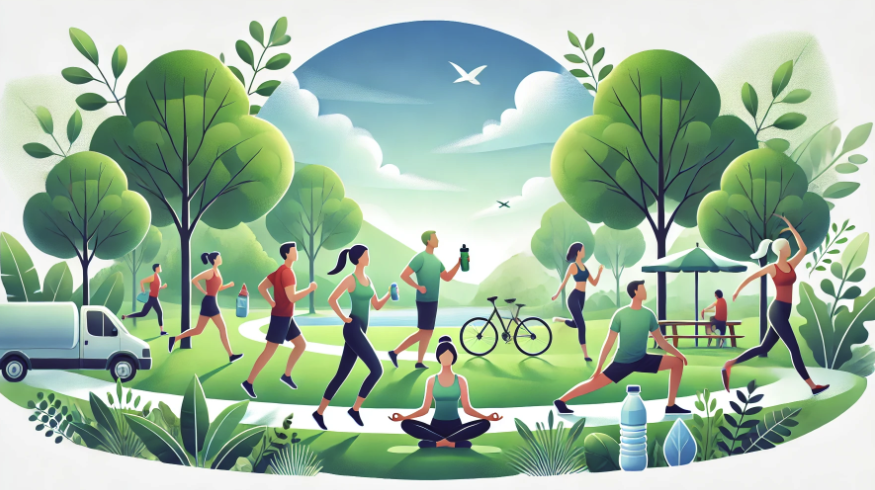Healing Through “MAGIC”
It’s not what you think it is…
Intention
I won’t go into the details yet, but let’s say that events during my time in the Marine Corps and throughout my life have led me to live in a constant state of hypervigilance, stuck in fight, flight, freeze, or fawn mode. About six years ago, I was diagnosed with PTSD and later with Complex PTSD and OCD.
Living with these mental health conditions has been debilitating. From battling agoraphobia to hiding knives to being unable to bathe my children, the impacts of OCD on my life were overwhelming and eventually led to multiple hospitalizations. I felt safer being institutionalized than being free. After a few hospitalizations, I decided to check myself into a longer-term mental health treatment facility.
Now, I am in a stable state. I’m enjoying my life, my family, and all the miracles of the present. I can cope with hardships quite well. It’s a significant success story!
So… what worked?
In this post, I want to share effective practices beyond the effective tools of evidence based therapy and medication management that make life magically better.
Did You Say MAGIC?
I’m not trying to induct anyone into a cult or share magic potions. The reality is that some practices help live life in a healthier mental state. I won’t say ‘happier,’ as a constant state of happiness is not achievable. A healthy mental state means being able to cope with the ups and inevitable downs that life brings. It’s about resiliency and harmony.
This may come as a surprise, but when you are institutionalized, you don’t just sit and put together puzzles all day (although you spend a reasonable amount of time on them). You spend your days learning about mental health and coping strategies. I have spent hours, days, and months focusing on coping strategies. I have lived the experience of being at rock bottom and found what actually works. This is not ‘magic’ in the sense of unrealistic solutions—neuroplasticity is very real, and most of these practices are based on it.
‘MAGIC’ is an acronym that stands for:
Mindfulness
Active
Generous
Interested
Connected
This is not a concept I invented. I learned it from my time in mental health treatment centers, and I have found it enormously effective. Practicing ‘MAGIC’ has transformed my life from a state of debilitating fear to one of serenity (and unicorns!). I genuinely want to share it in case it helps someone else.
‘M’ for ‘Mindfulness’
Mindfulness is like a magical spell that calms your mind, turning chaos into tranquility. Imagine your thoughts as mischievous pixies; with mindfulness, you gently guide them to settle, helping you focus and find peace in the present moment. It’s like discovering a hidden enchanted clearing where you can breathe deeply, appreciate the beauty around you, and handle life’s ups and downs with the grace of a zen wizard. Embrace the magic of mindfulness, and watch as it transforms your mental landscape into a serene sanctuary.
Mindful Breathing
Mindful breathing is like casting a spell of calm over your mind, turning chaos into tranquility. It involves focusing on your breath, paying attention to each inhale and exhale, and being present. This simple yet powerful practice offers numerous benefits. There are multiple mindful breathing techniques to try. My particular favorites are box breathing and visualization practice.
Box Breathing:
Inhale for four seconds.
Hold your breath for four seconds.
Exhale for four seconds.
Hold again for four seconds.
Repeat this cycle several times.
Visualization Practice:
Imagine you are in a field with mountains in the distance.
The weather is perfect (whatever that means to you).
In front of you, there is a deflated hot air balloon.
As you inhale, imagine filling the hot air balloon with air until it is complete.
With each exhale, use your breath to push the hot air balloon towards the mountains.
Guided Meditation
Guided meditation is like having a friendly wizard lead you through a magical relaxation and inner peace journey. It involves listening to a guide who helps you focus your mind and navigate through calming visualizations and instructions. This practice is incredibly beneficial for mental health. Below are my favorite guided meditation techniques:
Body Scan: This technique focuses on different body parts, from your toes to your head, releasing tension as you go.
Loving-Kindness Meditation: This practice involves sending thoughts of love and kindness to yourself and others, promoting compassion and connection.
Practicing Mindfulness
Practicing mindfulness is like adding a touch of magic to everyday activities, turning routine tasks into moments of calm and presence. Mindfulness involves paying full attention to the present moment and noticing your thoughts, feelings, and sensations without judgment. This practice can transform even the most mundane activities into relaxation and mental clarity opportunities.
Mindful Eating: Pay attention to the colors, smells, textures, and tastes of your food. Chew slowly and savor each bite, noticing how your body feels as you eat.
Mindful Showering: Focus on the sensation of the water, the smell of the soap, and the sound of the water hitting the shower floor. Let go of any distracting thoughts and immerse yourself fully in the experience.
Dream Journal
Dream journaling is like capturing the whispers of your subconscious, turning the mysterious language of dreams into a treasure trove of insights and reflections. This practice involves recording your dreams as soon as you wake up, allowing you to explore the hidden corners of your mind and uncover patterns and themes that may influence your waking life.
Keep a Journal by Your Bed: Keep a notebook and pen or a digital device within reach so you can record your dreams immediately upon waking.
Write in Detail: Note down as many details as possible, including emotions, colors, symbols, and any notable events or characters.
Reflect on Themes: Look for recurring themes, patterns, and symbols in your dreams. Reflect on what they might mean in the context of your waking life.
Asking How You Feel
Annotating feelings is like creating a magical map of your emotional landscape, helping you navigate the ups and downs of life with greater clarity and understanding. This practice involves regularly noting and describing your emotions, which can help you become more aware of your emotional state and how it changes over time.
Be Honest: Write your emotions as accurately and honestly as possible without judging yourself.
Use a Feelings Wheel: A feelings wheel can help you more precisely identify and describe your emotions.
Note Context: Include relevant events, thoughts, or physical sensations accompanying your emotions.
Grounding
Grounding in nature is like plugging yourself into the Earth’s energy, recharging your body and soul with the vitality of the natural world. This practice involves physically connecting with the ground, such as walking barefoot on grass or soil, to draw in nature's calming and rejuvenating benefits.
Barefoot Walking: Walk barefoot on grass, soil, sand, or any natural surface where you focus on the sensations under your feet and the connection with the earth.
Sitting on the Ground: Sit or lie on the ground, placing your hands and feet directly on the earth. Close your eyes and feel the connection with the ground.
Gardening: Engage in gardening activities, allowing your hands to contact the soil.
Nature Immersion: Spend time in natural settings such as forests, parks, or beaches. Engage your senses fully—notice the sounds, smells, and sights around you.
‘A’ for ‘Active’
Active practices are like casting spells of vitality, infusing your body and mind with energy and strength. Engaging in physical activities enhances your physical health and boosts your mental well-being, helping you stay resilient and vibrant. From the stimulating power of exercise to the calming benefits of yoga, active practices provide a dynamic way to combat stress, improve mood, and maintain a balanced, healthy lifestyle. These practices are essential to the MAGIC framework, supporting your journey to a more energetic and harmonious life.
Eat Healthy
Eating healthy is like fueling your magical journey with the finest elixirs, providing your body and mind with the nutrients they need to thrive. A balanced diet rich in fruits, vegetables, lean proteins, and whole grains can significantly enhance your mental and physical well-being, making it easier to handle life’s challenges with resilience and vitality.
Exercise
Exercising is like harnessing the power of a magical energy source, invigorating your body and mind with strength and vitality. Regular physical activity and intense exercise can significantly enhance your mental and physical health, helping you build resilience and maintain a balanced lifestyle. From the sweat-inducing power of a vigorous workout to the rhythmic flow of a brisk walk, exercise is a dynamic way to boost your well-being.
Find What You Enjoy: Choose activities like running, cycling, dancing, or weightlifting. This will make it easier to stick with your routine.
Mix It Up: Incorporate various exercises to keep things exciting and target different muscle groups.
Schedule It: Set aside specific times for exercise to ensure it becomes a regular part of your routine.
Listen to Your Body: Push yourself, but also be mindful of your body’s limits to avoid injury.
Drink Water
Drinking enough water is like keeping your magical elixirs topped up, ensuring that your body and mind function at their best. Staying hydrated is crucial for overall health and well-being, impacting everything from energy levels to mental clarity. Ensuring you drink enough water throughout the day is a simple yet powerful practice that can profoundly affect your life.
Carry a Water Bottle: Keep a reusable water bottle with you to ensure you can access water throughout the day.
Set Reminders: Use alarms or apps to remind you to drink water regularly.
Practice Yoga
Some people may need more time to be ready to hear this. However, this is an important one. Yoga is like weaving a tapestry of tranquility and strength, blending physical postures, breath control, and meditation to create a harmonious balance between body and mind. This ancient practice offers a holistic approach to health, helping you cultivate flexibility, reduce stress, and enhance mental clarity. Whether you're a seasoned yogi or a curious beginner, incorporating yoga into your routine can transform your well-being.
Start Slowly: Begin with basic poses and move to more advanced ones as your flexibility and strength improve.
Focus on Your Breath: Pay attention to your breathing, using it to guide your movements and enhance your practice.
Create a Comfortable Space: Find a quiet, comfortable space to practice yoga, free from distractions.
Be Consistent: Aim to practice regularly, even if it's just for a few minutes each day.
Listen to Your Body: Avoid pushing yourself too hard to respect your body’s limits. Yoga is about finding balance and harmony.
Shake Things Off
Shaking things off is like performing a magical dance to release pent-up energy and stress, allowing your body and mind to reset and refresh. This practice involves shaking your body to release tension, negative emotions, and anxiety. It’s a fun, simple, and effective way to boost your mood and overall well-being.
Find a Comfortable Space: Choose a space where you can move freely without interruptions.
Use Music: Play energetic music to make the practice more enjoyable and engaging.
Start Slowly: Begin by shaking your hands, then gradually involve your arms, shoulders, and the rest of your body.
Be Playful: Let go of any self-consciousness and embrace the silliness. The more you enjoy it, the more effective it will be.
‘G’ for ‘Generous’
Generous practices are like casting spells of kindness and connection, spreading joy and positive energy to those around you while enriching your life. Acts of generosity, whether through giving, volunteering, or simply practicing kindness, create a ripple effect that enhances your mental and emotional well-being. These practices strengthen your bonds with others and cultivate a sense of purpose and fulfillment, making generosity a powerful component of the MAGIC framework for a harmonious and meaningful life.
Gifting/Volunteering
Gifting and volunteering are like weaving enchantments of joy and connection, positively impacting others while nourishing your soul. These acts of generosity foster a sense of community, enhance your well-being, and add a sense of purpose and fulfillment to your life. Whether it's giving a thoughtful gift or offering your time and skills through volunteering, these practices can transform your life and those you touch.
Find Causes You Care About. Choose volunteer activities and gifting opportunities that align with your passions and values.
Start Small: Simple acts of kindness, like writing a heartfelt note or donating gently used items, can have a significant impact.
Be Consistent: Regularly engage in volunteering and gifting to build a habit of generosity.
Get Involved Locally: Look for opportunities in your community where you can see the direct impact of your efforts.
Share Your Experiences: Encourage others to join you in your generous acts, multiplying the positive effects.
Practice Kindness
Practicing kindness is like casting gentle spells of goodwill that brighten your day and the days of those around you. Small acts of kindness can transform ordinary moments into extraordinary ones, fostering a sense of connection, compassion, and happiness. Whether it’s a simple smile, a thoughtful gesture, or a few kind words, practicing kindness can profoundly impact your mental and emotional well-being.
Start Small: Simple actions like holding the door open, smiling, or complimenting sincerely can make a big difference.
Be Mindful: Pay attention to the needs and feelings of those around you, and look for opportunities to show kindness.
Listen Actively: Sometimes, the kindest thing you can do is to listen to someone without interrupting or judging.
Express Gratitude: Thank others and acknowledge their efforts and contributions.
Self High-fives
Self High-fives are like giving yourself confidence and positivity, celebrating your achievements, and encouraging self-love. This simple yet powerful practice involves giving yourself a high-five, reinforcing the idea that you are your own biggest supporter. It’s a fun and effective way to acknowledge your efforts and accomplishments and keep your spirits high, no matter how small.
Be Genuine: When you give yourself a high-five, do it with sincerity and enthusiasm, just as you would with someone else.
Celebrate Small Wins: Don’t wait for significant achievements. Celebrate small victories and everyday accomplishments.
‘I’ for ‘Interested’
Interested practices are like casting spells of curiosity and engagement, sparking joy and inspiration in your everyday life. By staying curious and actively pursuing your passions, you keep your mind sharp and your spirit vibrant. Whether diving into a good book, exploring new hobbies, or setting aside time for writing and reflection, these practices help you stay engaged with the world and connected to your inner self. Embracing your interests enriches your life and contributes to a balanced, fulfilling mental health routine, making each day an adventure filled with discovery and growth.
A Hobby a Day
Engaging in a hobby a day is like weaving spells of joy and creativity into your routine, bringing excitement and fulfillment to your everyday life. Pursuing hobbies helps you explore new interests, develop skills, and take a break from daily stresses. Whether painting, gardening, cooking, or playing a musical instrument, dedicating time to a daily hobby can rejuvenate your mind and spirit.
Choose What You Love: Pick hobbies that genuinely interest you and bring you joy.
Set Aside Time: Dedicate a specific time each day for your hobby, even if it’s just for a few minutes.
Be Flexible: Don’t stress about being perfect. The goal is to enjoy the process and have fun.
Explore New Interests: Try different hobbies to discover new passions and keep things exciting.
Writing
Writing is like casting spells of expression and reflection, transforming your thoughts and emotions into words that can heal, inspire, and clarify. Whether through journaling, creative writing, or simply jotting down your daily experiences, writing is a powerful tool for enhancing mental and emotional well-being. This practice allows you to explore your inner world, process your feelings, and communicate your ideas effectively.
Start Journaling: Set aside time daily to write about your thoughts, feelings, and experiences. It doesn’t have to be lengthy; even a few sentences can be beneficial.
Try Creative Writing: Write stories, poems, or essays. Let your imagination run wild, and enjoy the creative process.
Use Prompts: If you’re unsure where to start, use writing prompts to inspire your writing. Prompts can spark ideas and help you explore new topics.
Write Freely: Don’t worry about grammar or perfection. Allow your words to flow naturally and focus on the process rather than the outcome.
Reading
Reading is like opening portals to new worlds, where you can embark on adventures, gain knowledge, and find solace. This magical practice not only entertains but also enriches your mind and spirit. Whether delving into fiction, exploring non-fiction, or diving into poetry, reading offers endless opportunities for growth, relaxation, and inspiration.
Set Aside Time: Dedicate specific times each day for reading, whether it's in the morning, during lunch breaks, or before bed.
Create a Reading Nook: Designate a comfortable, quiet space for reading, free from distractions.
Choose What You Love: Select books that interest you, whether they're novels, biographies, self-help, or any other genre.
Scheduled Worry Time
I laughed when I first heard this one, but then I gave it a shot! Scheduled worry time is like casting a spell to contain and control your anxieties, allowing you to manage your worries effectively rather than letting them take over your day. This practice involves setting aside a specific time each day to focus on your fears. Doing so allows you to postpone anxiety until this designated period. By doing so, you can reduce overall stress and improve your ability to stay focused and present throughout the day.
Choose a Consistent Time: Select a specific time each day for your worry period, preferably in the evening, to avoid carrying worries into bedtime.
Set a Time Limit: Limit your worry time to 15-30 minutes to prevent it from becoming overwhelming.
Use a Worry Journal: Write down your worries, permitting yourself and possible solutions or actions you can take.
Postpone Worries: When worries arise throughout the day, remind yourself that you will address them during your scheduled worry time.
‘C’ for ‘Connected’
Connected practices are like weaving threads of community and belonging into the fabric of your life, fostering relationships that support and uplift you. Connecting with others enriches your mental and emotional well-being, providing security, purpose, and joy. Whether it's through nurturing friendships, engaging in community activities, or exploring spirituality, these practices help you feel more integrated and supported. Embracing connectedness ensures you are not alone in navigating life's challenges but are surrounded by a network of care and shared experiences.
Community
Community is like a magical network of support and camaraderie that surrounds you with care and connection. Being part of a community provides a sense of belonging, enriches your life with shared experiences, and offers mutual support during solid, joyful, and challenging times. Whether it’s through local groups, online forums, or shared interest clubs, engaging with a community enhances your mental and emotional well-being.
Find Local Groups: Look for local clubs, groups, or organizations that align with your interests and values.
Attend Community Events: Participate in local events, workshops, and gatherings to meet new people and strengthen existing relationships.
Join Online Communities: If local options are limited, online forums and social media groups can also provide a sense of community and connection.
Be Open and Involved: Be open to meeting new people and actively engage in community activities to build strong, meaningful connections.
Spirituality
Spirituality is like tuning into a mystical frequency that connects you to a more profound sense of meaning, purpose, and peace. Engaging with your spiritual side can take many forms, from meditation and prayer to exploring nature or practicing gratitude. Spirituality provides a sanctuary for your mind and soul, offering comfort and guidance through life's ups and downs. By nurturing your spiritual practices, you can enhance your mental and emotional well-being, fostering a profound sense of connection and inner harmony.
Explore Different Practices: Experiment with spiritual practices such as meditation, prayer, yoga, or nature walks to find what resonates with you.
Create a Sacred Space: Designate a quiet, peaceful area in your home for spiritual activities and reflection.
Connect with Like-minded Individuals: Join spiritual groups or communities to share experiences and deepen your practice with others.
Practicing Gratitude
Practicing gratitude is like sprinkling your life with magic, transforming ordinary moments into sources of joy and appreciation. Regularly acknowledging and appreciating your life's positive aspects can cultivate a more optimistic outlook and enhance your overall well-being. Gratitude shifts your focus from what you lack to what you have, fostering a sense of abundance and contentment.
Keep a Gratitude Journal: Write down a few things you are grateful for each day and reflect on big and small blessings.
Express Gratitude to Others: Take the time to thank people in your life, whether through a heartfelt note, a phone call, or a simple thank-you.
Share Gratitude: Discuss what you are grateful for with friends and family, creating a culture of appreciation within your social circles.
Putting it Together
Incorporating magic into daily life involves many steps, but they are worth the effort. I keep a journal prompt with the following intentions daily to ensure I'm nurturing my mental and emotional well-being. There is a lot to do, and I only accomplish some things in one day, yet I always try my best.
M:
Mindful Breathing
Guided Meditation
Mindful Shower/Eating
Dream Journal
Asking my feelings
Grounding
A:
Eat Healthy
Exercise
Drink 96 oz of water
Practice Yoga
Shake things off
G:
Gifting or Volunteering
Practice Kindness
Self High-Five
I:
Practice Hobby
Write
Read
Scheduled Worry Time
C:
Community
Spirituality
Gratitude
Healing and maintaining mental health are not effortless endeavors, much like the effort required to practice MAGIC. Each letter of MAGIC—Mindfulness, Active, Generous, Interested, and Connected—represents a set of practices that can significantly enhance your mental and emotional well-being. These practices help rewire the brain, fostering resilience and harmony in the face of trauma and mental health challenges.
Incorporating these practices into your daily life is crucial because they provide a structured approach to self-care and healing. Mindfulness practices like breathing and meditation ground you in the present moment, reducing stress and anxiety. Active practices, including exercise and yoga, invigorate your body and mind, boosting overall health. Generous practices, such as volunteering and practicing kindness, create a sense of community and purpose. Interested practices, like reading and engaging in hobbies, stimulate your mind and keep you curious and motivated. Lastly, connected practices, such as fostering community and spirituality, ensure you are supported and feel a sense of belonging.
Although integrating these practices into your routine takes work, and some are mundane, the benefits are profound. They transform your everyday life, helping you navigate challenges more easily and cultivate a sense of joy, fulfillment, and balance. Embracing magic is a powerful step towards healing and achieving a healthier, more harmonious life.








